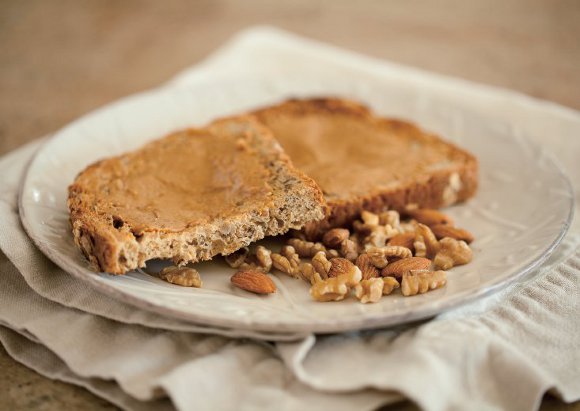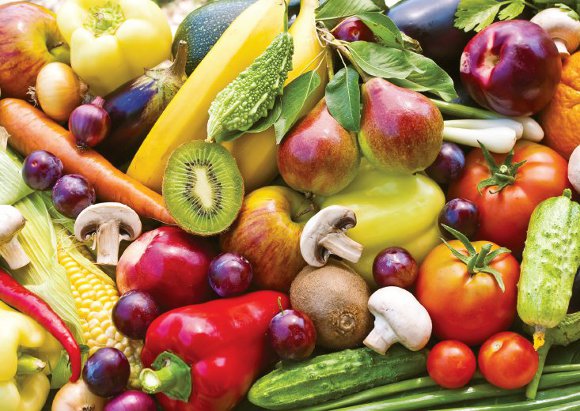One
What It Means
If you lead a sedentary, fast-food-laden lifestyle—meaning that you spend most of your time sitting, whether at work or home, and scarfing down a drive-through lunch or dinner—you are not alone. In fact, this way of life is not only a nationwide problem, it’s becoming a worldwide epidemic. As corporations continue to export tasty, processed, sugary, fatty foods to countries all over the world, millions of people face the prospect of obesity. As a reporter, I’m telling you, as long as there are billions of dollars in profits available, there is no reason for companies to stop producing food that is guaranteed to make you unhealthy and fat.
That’s why what you eat is up to you. You must put your foot down. You need to begin to regulate your own behavior by turning away from what you’ve come to know as fast and satisfying and start to reach for foods that will actually nourish you. Do this, and skinny will be the by-product. But your first concern should always be your health.
So how do you get there?
You go clean.
Clean eating means eating foods that are processed minimally, if at all. It means consuming foods closest to their natural state. You won’t find any pre-packaged, heavily processed, refined, or fast foods here. By avoiding those foods, you allow your body to rid itself of toxins and flush out unnecessary fat.
When you can, you’ll be eating fruits and vegetables straight from your local market, a farmers’ market, or, if possible, your own garden. No fake flavors allowed. Eat an apple, not something apple-flavored. No ingredients that you can’t pronounce.
The Quick & Clean Diet is not about cutting out carbs; it’s about avoiding starchy, sugary carbs. It’s not about going fat-free. It’s about choosing good fats. And it’s about eating plenty of lean proteins, including chicken, turkey, and fish—even shrimp or tofu if you choose—while avoiding those that are high in artery-clogging saturated animal fats.
Lean Proteins Keep You Lean
When we think of protein, we generally think of meat, poultry, and fish. But there is also protein in beans, dairy, eggs, soy, and quinoa, which is a grain. In fact, soy (as in tofu) and quinoa are the only two vegetarian sources of complete protein, meaning that they provide all of the essential amino acids your body needs but can’t make for itself.
Animal sources all provide complete protein, but most meat protein also comes with quite a lot of fat, and it’s saturated fat, which is not very good for your heart. Chicken and turkey (particularly the white meat) have a lot less fat, especially if you remove the skin, where most of the fat is stored. And fish has omega-3 fatty acids, which your body requires. Omega-3s are polyunsaturated fats that can actually help to lower blood cholesterol and triglyceride levels and reduce your risk of heart diseases.
On the Quick & Clean Diet, you’ll eat plenty of lean protein.
Fats: The Good, the Bad, and the Really Ugly
Aside from omega-3 fatty acids, the other “good fats” are monounsaturated. They are the fats that remain liquid at room temperature, which means that you probably think of them as oils. Olive oil is likely the monounsaturated fat we use most frequently, but others include canola and peanut oils. Many nuts, as well as avocados, olives, and pumpkin seeds, also contain monounsaturated fats.

Although in terms of calories, fat is fat, and all fat has 9 calories per gram—more than twice as many as either protein or carbs—your body needs fat to function, and unsaturated fats, consumed in moderation, are considered to be heart-healthy. In fact, consumption of olive oil is one reason why the diet naturally followed by people who live near the Mediterranean is considered to be so good.

Saturated fats, as I’ve said, are those found mainly in meat, poultry skin, eggs, and full-fat dairy products, and are known to raise LDL (“bad”) cholesterol.
Trans fats are the most evil. Why? Not only because many studies have shown that they increase your LDL (bad) cholesterol, thereby increasing your risk for cardiovascular disease, but also because they are man-made. That’s right: Trans fats are made by partially hydrogenating perfectly healthy vegetable oils so that they remain solid at lower temperatures, thereby helping to increase the shelf life of baked goods and many snack foods. Initially trans fats were also used to keep stick margarines solid and spreadable. Unlike animal fat (from which butter is made), vegetable oils (used to make margarine) do not solidify when cold, so the vegetable oil was partially hydrogenated to get it to solidify. Now, however, many margarines are made without trans fats. So if you use it, be sure to read the label. And any time you see the words hydrogenated or partially hydrogenated on any food package, put it back on the shelf and walk away.
Not All Carbs Are Created Equal
The truth is, carbohydrates tend to get a bad rap. That’s because when people think of carbs, they immediately think about starch and sugar. But the fact is, all fruits and vegetables contain carbohydrates.
What are generally called simple carbs are, well, simply sugar. It’s what’s in your sugar bowl, in candy, cookies, cake, ice cream, soda, and syrups. The problem with simple carbs is that they have a lot of calories and virtually no nutritional value. They are also digested very quickly so that they give you a quick energy boost (not to mention a sweet treat) and then cause your blood sugar to drop rapidly so that you’re left feeling let down and craving more. (I’ll be talking much more about blood sugar levels and how they affect your weight and overall health in chapter 2.) On the Quick & Clean Diet, you’ll be avoiding simple carbs.

Beyond the rise and fall in blood sugar, however, studies are beginning to show that sugar is actually addictive. Researchers at Princeton University found that rats fed diets high in sugar experienced changes in the brain similar to those associated with people who abuse drugs like cocaine and heroin. When they were deprived of sugar, the rats got “the shakes”—a symptom generally associated with withdrawal from drugs or alcohol.
In addition, Dr. Robert Lustig and his colleagues at the University of California–San Francisco have studied the effects of sugar on brain chemistry and concluded that consuming sugar causes us to simultaneously feel hungry and store fat. Furthermore, these researchers confirmed that sugar is addictive in much the same way as drugs and alcohol.
That sounds pretty scary to me!
Complex carbs are basically starch—that is, a bunch of sugar molecules strung together—which is turned into glucose (sugar) when we digest it. All kinds of grains, as well as potatoes, rice, and beans, are complex carbohydrates. Grains are used to make pasta, breads, and cereals, and the kinds of grains that are used generally determine how quickly they turn to sugar after you eat them. Whole grains are the least processed and therefore take the longest to digest, meaning that they don’t cause your blood sugar to spike and drop as quickly as more highly processed grains. So whole wheat bread is better than white bread; whole wheat pasta is better than white pasta; and whole grain cereals are better than those that have been flaked or puffed (and certainly better than those that have been presweetened).
But what about fruits and vegetables? Well, all fruits are basically fructose (fruit sugar), which your body turns into glucose. And all vegetables contain some carbohydrates. Some fruits (such as bananas) and vegetables (such as corn) are “starchier” than others. But all fruits and vegetables also contain important nutrients, and they all contain substantial amounts of fiber.
Fiber is important for a couple of reasons. First of all, it takes longer for your body to process foods that contain a lot of fiber, which means that they turn to sugar much more slowly and don’t cause your blood sugar to spike. And second, fiber is indigestible, so it helps you to feel full without adding calories to your meal.
When you read about the three stages of the Quick & Clean Diet in part 2, you’ll see that the kinds of carbs you’re allowed to eat in Stage One (the cleansing and jump-starting stage) are quite restricted. Then, as you move to Stage Two and Stage Three, more and more carbs will be included so that your new way of eating becomes easily sustainable for the rest of your life.
What You Need to Know about the Glycemic Index
If you’ve been on any kind of diet in the last decade or so, you’ve no doubt heard about the glycemic index. And you probably know that consuming foods with a low glycemic index rating is “good,” while foods high on the glycemic index are “bad.” But do you actually know what all that means?

Actually, the glycemic index is a measure of the degree to which foods that contain carbohydrates raise your blood sugar. Glucose—that is, pure sugar—is rated 100, and all other foods are rated relative to that. So basically, simple carbs and starchy complex carbs are listed highest on the index while most vegetables (including all the leafy greens) and many fruits (such as blueberries, blackberries, and strawberries) are lower.
The carbs you’ll eat on this diet are all relatively low on the glycemic index.
How It’s Going to Work
In part 2 I’ll give you a step-by-step guide with food lists and meal plans, but before you begin you’d probably like to know what you’re signing up for. I know I would. So here’s a quick overview.
The Quick & Clean Diet is, as I’ve said, divided into three stages.
STAGE ONE
High Motivation is designed to detox your system from all the bad stuff you’ve probably been putting in your body, stabilize your blood sugar, kill your cravings, and jump-start your weight loss. It is definitely the most restrictive stage, but it’s only for fourteen days and the rewards you’ll see in terms of looser clothes, greater energy, and a sharper mind will be well worth the effort. By the time it’s over, a switch in your brain will have flipped, the lightbulb will go on, and you’ll be thinking, Wow, I really like what’s happening here.

STAGE TWO
Grounding is when you’ll start to add a wider variety of foods to your meal plan. You’ll lose about two pounds a week—although everyone is different, so you may lose more or less—and your body will continue to change in the way it responds to food. Soon you’ll find that you no longer long for those sweet and simple carbs. Instead you’ll actually crave the clean, whole foods that give your body more energy and your brain more clarity. You may not even have realized how fuzzy and sluggish you used to feel so much of the time. That was all a part of the blood sugar highs and lows that are no longer a part of your life.
STAGE THREE
Stability: You’ll stay on the Grounding Stage until you reach your goal weight and then move on to Stability. Here you will eat an even wider variety of foods and be more motivated than ever to maintain your new slim and sexy figure.
The goal, of course, is to maintain good health and stable eating habits. Realistically, however, this may be challenging at times. But now that you know what to do and how to do it, if you do fall off the horse, so to speak, during the holidays or when you’re on vacation, you’ll be able to get right back on by returning to the High Motivation Stage for a week or two before the situation gets out of hand.
But before we get all excited about looking fabulous (you will!), we need to talk about why it’s so important to be at your proper weight.
